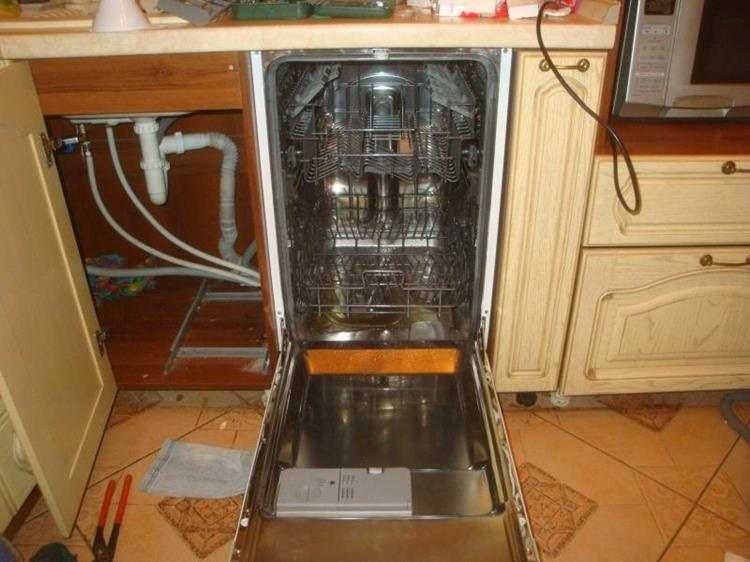Dishwashers are installed in the kitchen, close to the sink. This is not for nothing. In this case, the connection of the dishwasher is the easiest – the sewer and water supply are next to each other, and you still need to install a separate outlet for the fixed connection.
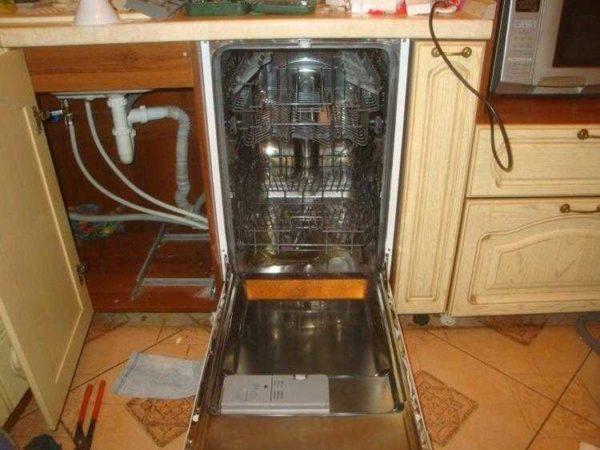
The peculiarity of installing a dishwasher is that it must be perfectly level. The maximum permissible deviation from the horizontal is 2°. If this requirement is not met, the dishes may not be washed well enough. Therefore, the first step after unpacking is to put it in place and level it. For this purpose, there are height-adjustable feet in the design. We take a construction level, lay it on the machine and make sure that it stands level with respect to the horizontal. Then check the verticals, if everything has been done correctly, and here there should be no deviations.
Article content
Power supply requirements
Dishwashers, even economical ones, consume a considerable amount of electricity. For example:
- BOSCH SPS 40E12 (class A) has a maximum power consumption of 2.4 kW;
- CANDY CDCF 6 07 (class A) consumption – 1.3 kW.
- SIEMENS SR24E205 (class A) maximum power consumption is 2.4 kW;
- ELECTROLUX ESF 9420 LOW – can consume 2.1 kW.
- WHIRLPOOL ADP 7570 IX – consumes 2.1 kW.
With high power consumption, one of the conditions for normal operation is a separate power supply line with an installed circuit breaker and RCD. A separate line will also reduce the impact of power surges on the electronics that control the unit’s operation. These are felt whenever the refrigerator, freezer or microwave is turned on/off. The control board reacts very badly to all the surges, and its replacement (almost nobody repairs it, only replaces it) costs a lot of money. If you want the equipment to work for a long time and without problems – pull a separate line from the board.
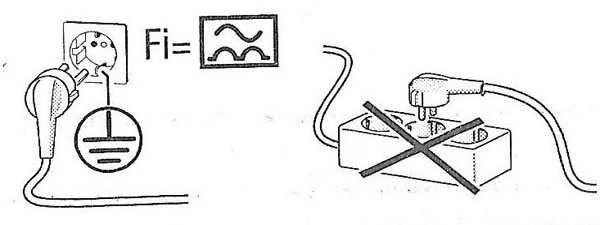
As you have understood, the average power of a dishwasher is 2,1-2,4 kW. First, we choose the automatic protection device. It should be selected by current, but the characteristics rarely have this value, so you have to calculate the current by power. For example, the power of the dishwasher is 2.4 kW. Find the maximum current: 2400 W / 220 V = 10.9 A.
Automatic protection devices are available in the following ratings – 6 A, 10 A, 16 A, 20 A (there are more powerful, but for this equipment they are definitely not needed). For this example we need a 16 A circuit breaker. It is better not to take 10 A – at switching on at full power it will be knocked out. Therefore, we take the nearest larger value, which is 16 A.
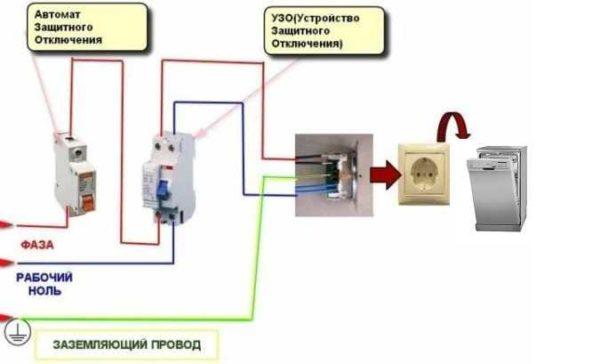
From the input of the circuit breaker, the phase is fed to the RCD. It protects against leakage in case of insulation breakdown, it will also work if someone touches live parts. It is also selected according to the current, but must be a step higher than the automatic circuit breaker. For this example – it is 25 A (RCDs come in 10 A, 16 A, 25 A, 32 A). The second parameter on which to choose this type of protection is the leakage current. For lines to which only one device is connected, the leakage current is 10 mA. Both of these devices are installed in the house or apartment switchboard.
Another parameter to determine is the cross-section of the cable cores. Recently, copper wires are used for wiring, as they are easier to work with. For devices with a power of up to 4.1 kW, a cross-section of 1.5 square millimeters is enough (you can more, less – no).
Now about what kind of sheathing the cable should be in. This depends on the material of the walls on which the power line will be laid:
One more point: the outlets for the dishwasher must be grounded. This is a mandatory requirement to maintain the warranty. Also when choosing, pay attention to the voltage for which it is designed. In branded copies, this parameter is written on the back side. If there is no such inscription – in front of you is a cheap Chinese consumer, and it is better not to risk it.
Where and how to discharge the drain
The next stage is the connection of the dishwasher to the sewer system. The drain hose is located on the back wall of the case, it has a length of about 1.5-2 meters. If necessary, it can be extended with a similar one of the same diameter, but the total length can not be more than 5 meters (for exact details, see the instruction manual). This distance in can pump pumps that work in the removal of water.
The best option is to have a separate sewer outlet. Then everything is simple, a rubber coupling is inserted into the spigot, providing a tight fixation of the corrugation, the end of the drain hose is tucked into it. If it is closed with a plug, remove it. But this option is rather an exception. More often connect the dishwasher through the siphon of the sink or through the output in the sink.
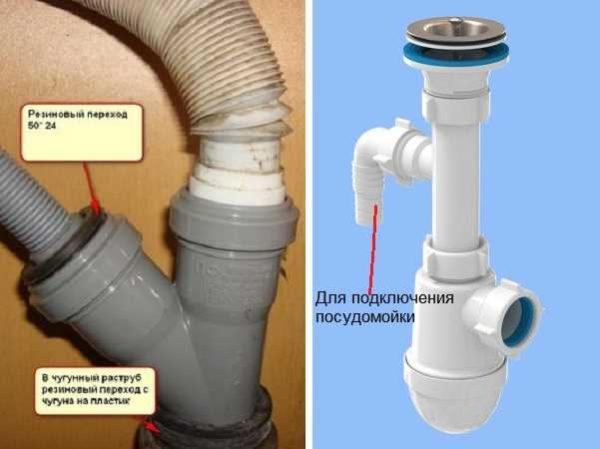
If the sewer outlet is cast-iron, there are special rubber couplings for a tight transition to plastic. You will need to know the diameters of your outlet and the plastic tee. Accordingly, the adapter is installed in the cast iron pipe. It just needs to be tucked in there without any additional means. A plastic fork is inserted into the coupling. In the vertically directed branch usually connect the sink, in the one at an angle – dishwasher.
In special siphons for connecting the dishwasher, the outlet is made so that the drain hose can be stretched over it. For reliability, it can be tightened with a clamp.
Connection of the dishwasher to the sewer system should be such as to avoid the formation of loops and breaks, and even then, even when everything is pushed into place. At the same time, the corrugation should not be allowed to approach from the side – there should be a slight upward bend. This eliminates the possibility of runoff from the siphon or tee into the machine.
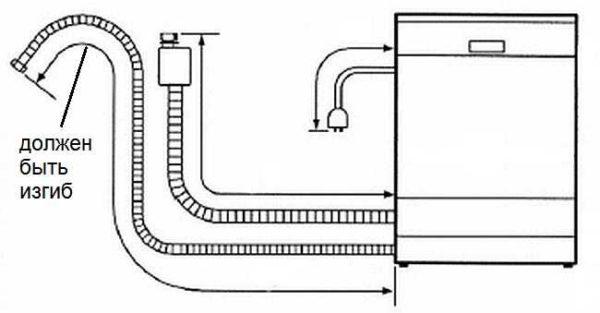
To fix the corrugated hose in a given position, there are special plastic couplings. They are put on the corrugation from below and hold it securely.
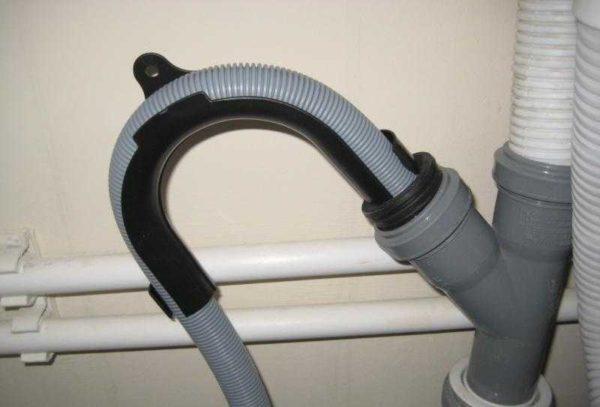
Connection to the water supply
The dishwasher is connected to the water supply using the standard hose, which is also located on the rear side of the housing. It is easily recognized by the rather large nozzle. This is an overflow blocker. It is necessary for correct operation and it is not recommended to remove it.
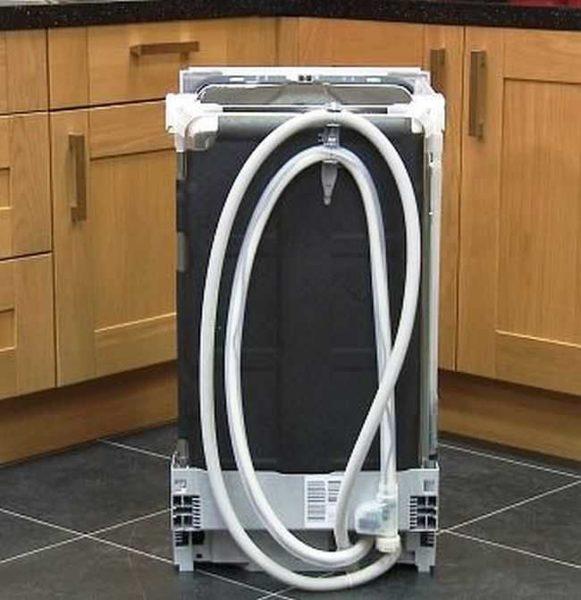
Now about what water to connect the dishwasher to. You can connect to hot water only in one case – if your machine supports this function (it is indicated in the description) and you do not have a meter for DHW. In all other cases, it is better to fill the machine with cold water. The main motive for connecting to DHW is to save electricity. If the water is hot, it does not need to be heated. This is true, but such a solution has disadvantages:
You can connect to the water supply at any point where there is a plug connection. For example, in the place where the flexible hose is connected to the sink. It is unscrewed, put a tee, then a ball valve (or a tee with a ball valve at once). On the part that is connected to the faucet dishwasher, on the second output – a flexible hose to the sink mixer.
Checking before start-up
Before pushing the machine into place, check the tightness of the connections. To do this, open the water supply (turn the faucet to which the filling hose of the dishwasher is connected). If there are no leaks anywhere, you can push the machine in.

